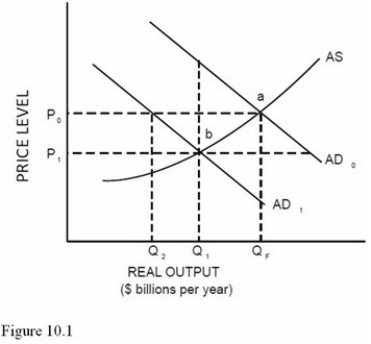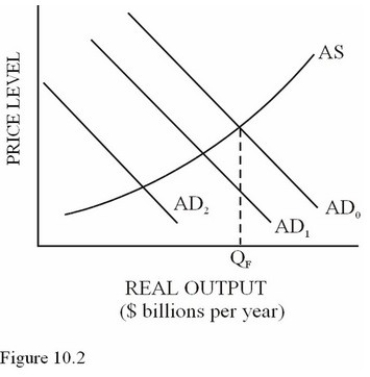A) Aggregate supply equals aggregate demand.
B) The economy is at full employment.
C) The price level is stable.
D) The price level is too low.
Correct Answer

verified
Correct Answer
verified
Multiple Choice
 In Figure 10.1,which of the following could cause a shift from AD0 to AD1,ceteris paribus?
In Figure 10.1,which of the following could cause a shift from AD0 to AD1,ceteris paribus?
A) An increase in consumer confidence.
B) A decrease in interest rates.
C) A decrease in government spending on the education.
D) An increase in exports.
Correct Answer

verified
Correct Answer
verified
True/False
Undesired inventory depletion results in demand-pull inflation.
Correct Answer

verified
Correct Answer
verified
Multiple Choice
A basic conclusion of Keynesian analysis is that
A) Small macro disturbances can lead to much larger macro problems.
B) The economy self-adjusts to reach full employment and a stable price level.
C) Equilibrium GDP is consistent with full employment.
D) Equilibrium GDP is consistent with price level stability.
Correct Answer

verified
Correct Answer
verified
Multiple Choice
Injections include
A) Business saving.
B) Taxes.
C) Exports.
D) Consumer saving.
Correct Answer

verified
Correct Answer
verified
Multiple Choice
To illustrate the ultimate impact of the multiplier process when investment spending falls,we should
A) Shift the AD curve rightward once.
B) Shift the AD curve leftward twice,once for the autonomous change and second for the multiplier effect.
C) Shift the AD curve leftward and then rightward.
D) Shift the AD curve leftward and then shift the AS curve leftward.
Correct Answer

verified
Correct Answer
verified
Multiple Choice
When unwanted inventories pile up in retail stores,retail managers will take actions that lead to greater
A) Inflation.
B) Unemployment.
C) Wages.
D) Economic growth.
Correct Answer

verified
Correct Answer
verified
Multiple Choice
Given C = 200 + 0.75YD,the multiplier is
A) 0.25.
B) 0.75.
C) 4.
D) 1.33.
Correct Answer

verified
Correct Answer
verified
Multiple Choice
Suppose lower interest rates suddenly lead to an injection of $325 additional investment spending into the economy and the marginal propensity to consume is 0.80. Table 10.1 In Table 10.1,what is the change in the third cycle of spending resulting from the higher initial investment?
A) $50.
B) $208.
C) $325.
D) $585.
Correct Answer

verified
Correct Answer
verified
Multiple Choice
In the short run,if AD increases,the unemployment rate will
A) Rise,and the price level will rise.
B) Fall,and the price level will rise.
C) Rise,and the price level will fall.
D) Fall,and the price level will fall.
Correct Answer

verified
Correct Answer
verified
Multiple Choice
If an increase in investment causes an increase in real output beyond the full-employment level,the result will be
A) Demand-pull inflation.
B) An increase in the recessionary GDP gap.
C) Cost-push inflation.
D) An increase in undesired inventories.
Correct Answer

verified
Correct Answer
verified
Multiple Choice
Assuming an upward-sloping AS curve,if an economy is at full employment and consumption spending decreases while all other levels of spending remaining constant,then
A) Increased unemployment results.
B) Any GDP gap disappears.
C) Inventory levels are less than desired until a new equilibrium is reached.
D) Changes in consumption spending have no impact on GDP.
Correct Answer

verified
Correct Answer
verified
Multiple Choice
If investment spending decreases and all other levels of spending remain constant,then aggregate
A) Supply increases.
B) Supply decreases.
C) Demand increases.
D) Demand decreases.
Correct Answer

verified
Correct Answer
verified
Multiple Choice
If the MPC = 0.90,the total change in spending resulting from an initial $200 increase in aggregate spending will be
A) $2,000.
B) $200.
C) $180.
D) $1,800.
Correct Answer

verified
Correct Answer
verified
Multiple Choice
 Suppose the MPC in the economy in Figure 10.2 equals 0.5 and the shift from AD0 to AD1 was caused by a decrease in consumption of $12 billion.What will the total decrease in aggregate demand be (for example,AD0 to AD2) as a result of the initial $12 billion decrease?
Suppose the MPC in the economy in Figure 10.2 equals 0.5 and the shift from AD0 to AD1 was caused by a decrease in consumption of $12 billion.What will the total decrease in aggregate demand be (for example,AD0 to AD2) as a result of the initial $12 billion decrease?
A) $12 billion because there are no multiplier effects associated with a change in consumption.
B) $600 billion.
C) $24 billion.
D) $60 billion.
Correct Answer

verified
Correct Answer
verified
Multiple Choice
Suppose lower expectations lead to a decrease of $240 in desired investment in the economy and the marginal propensity to consume is 0.75. Table 10.2 In Table 10.2,what is the cumulative decrease in expenditure by the end of the second cycle?
A) -$960.00.
B) -$180.00.
C) -$480.00.
D) -$420.00.
Correct Answer

verified
Correct Answer
verified
Multiple Choice
If leakages are less than injections,equilibrium output will be
A) Less than full-employment output,and a recessionary gap will occur.
B) More than full-employment output,and a recessionary gap will occur.
C) Less than full-employment output,and an inflationary gap will occur.
D) More than full-employment output,and an inflationary gap will occur.
Correct Answer

verified
Correct Answer
verified
Multiple Choice
Suppose lower expectations lead to a decrease of $240 in desired investment in the economy and the marginal propensity to consume is 0.75. Table 10.2 In Table 10.2,what will be the total decrease in aggregate demand resulting from the initial $240 decrease in investment expenditure after an infinite number of cycles?
A) -$960.00.
B) -$135.00.
C) -$555.00.
D) -$240.00.
Correct Answer

verified
Correct Answer
verified
Multiple Choice
If actual investment exceeds desired investment,then
A) A recession can develop.
B) Leakages are greater than injections.
C) An inflationary spiral can develop.
D) Leakages are equal to injections.
Correct Answer

verified
Correct Answer
verified
Multiple Choice
When the economy is at equilibrium,
A) Leakages equal injections.
B) Inventories must equal zero.
C) Leakages equal aggregate demand.
D) There are no leakages.
Correct Answer

verified
Correct Answer
verified
Showing 81 - 100 of 140
Related Exams